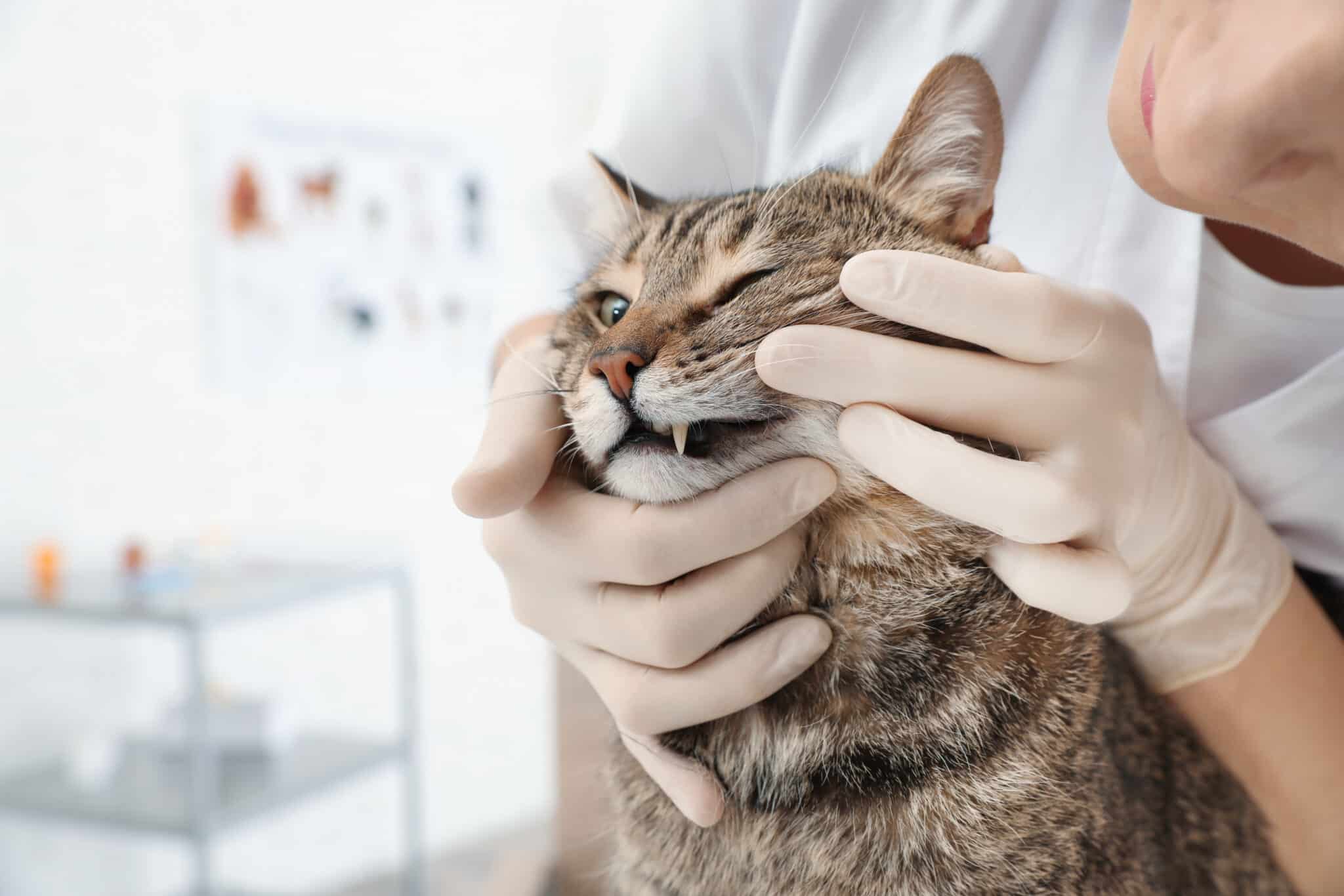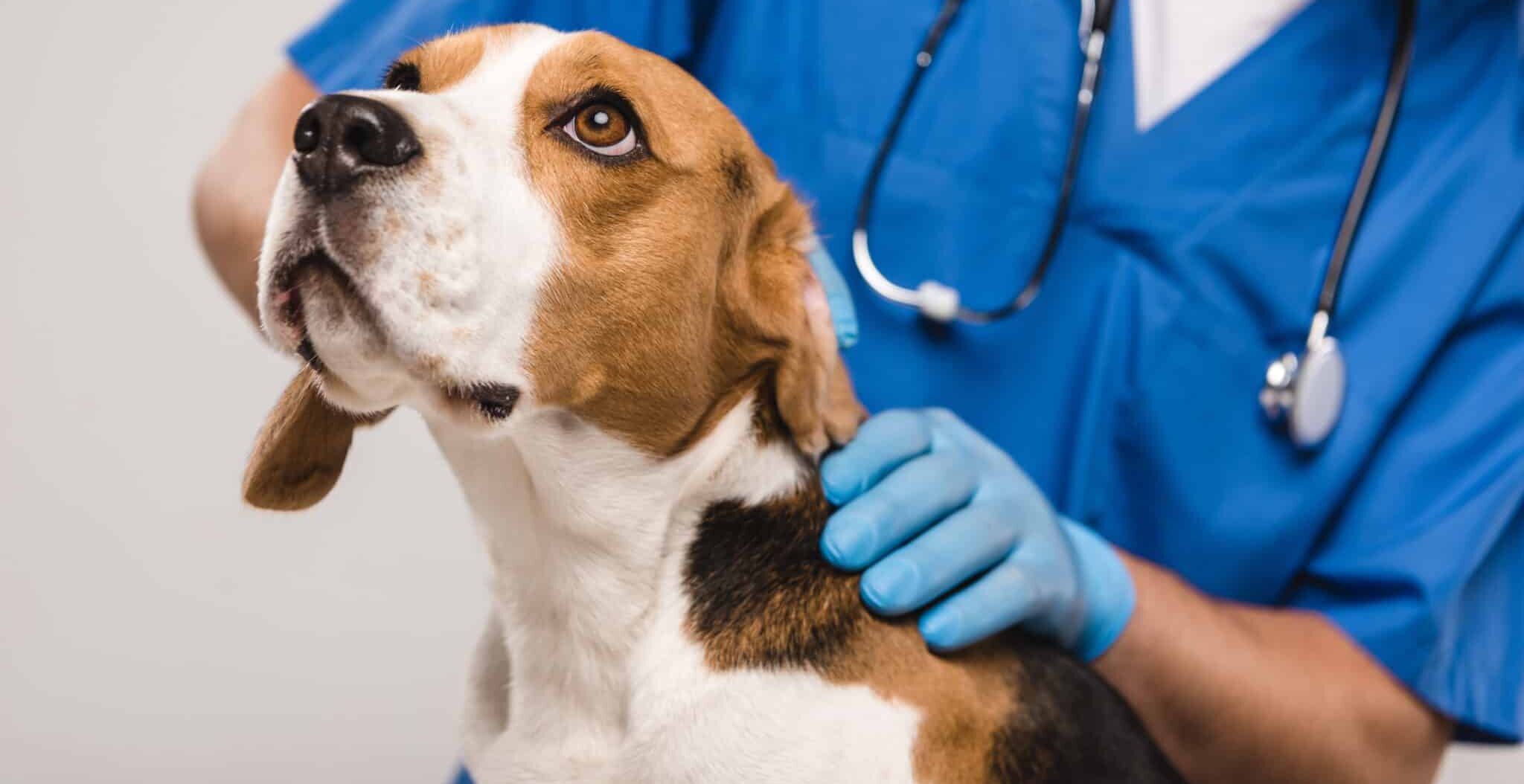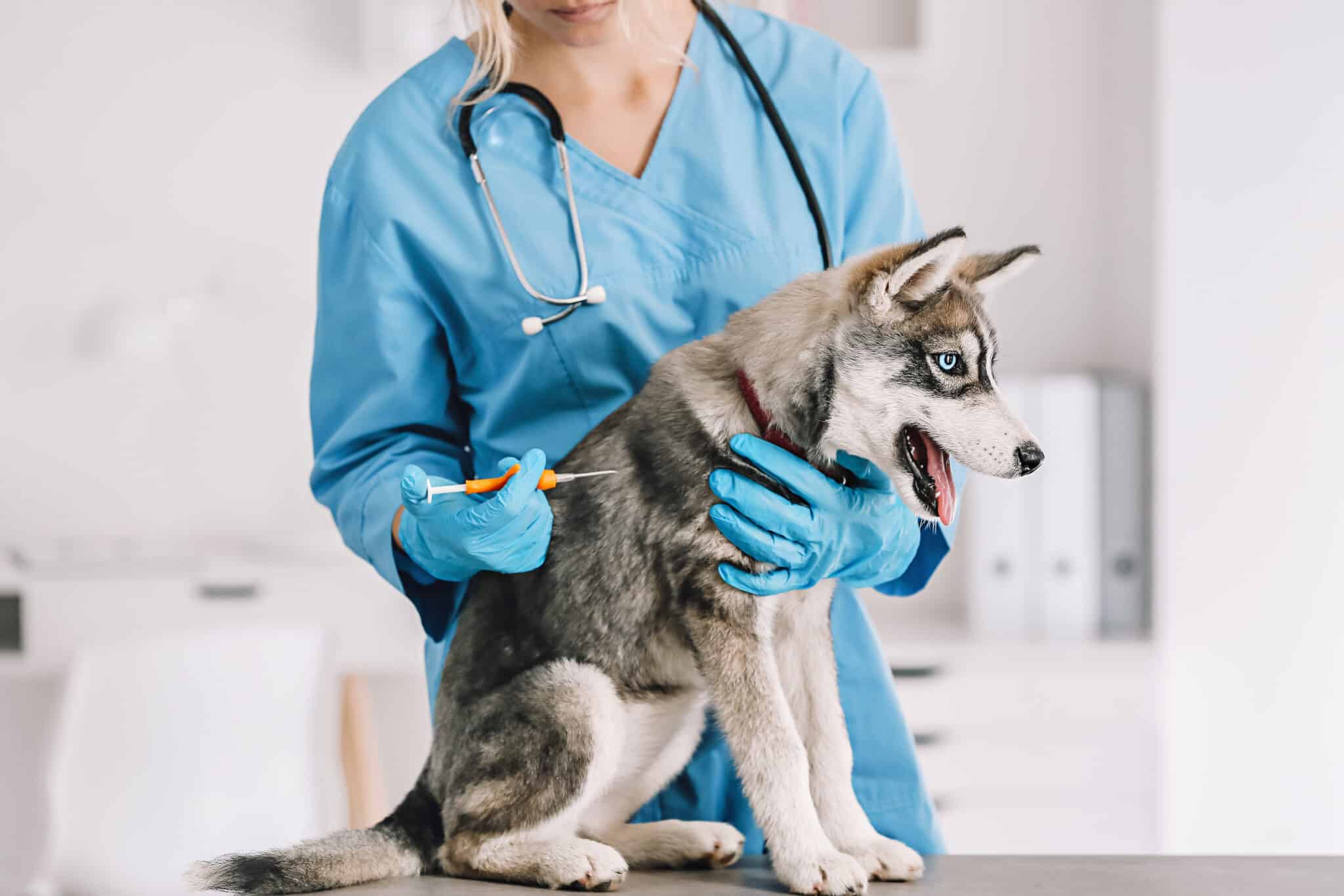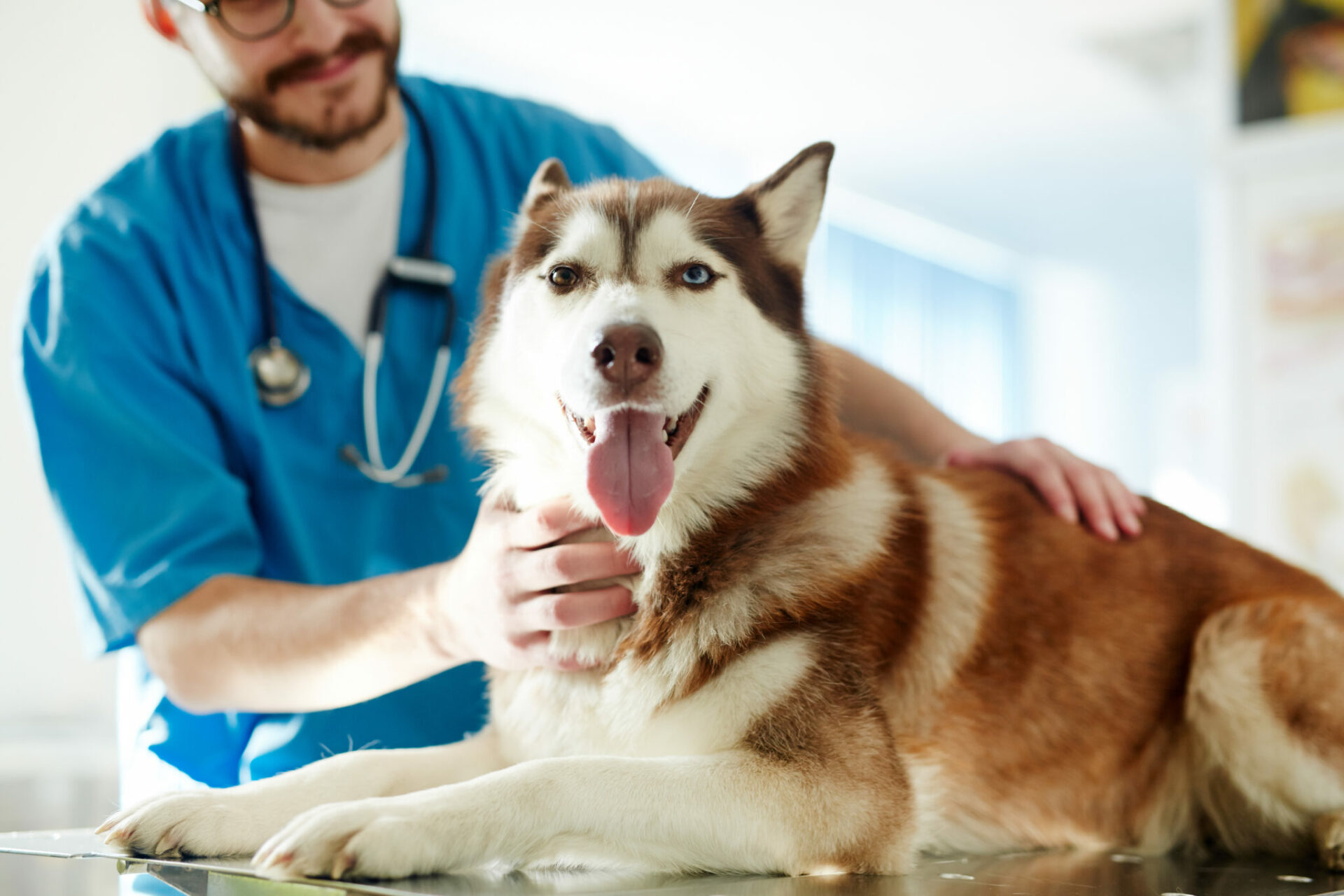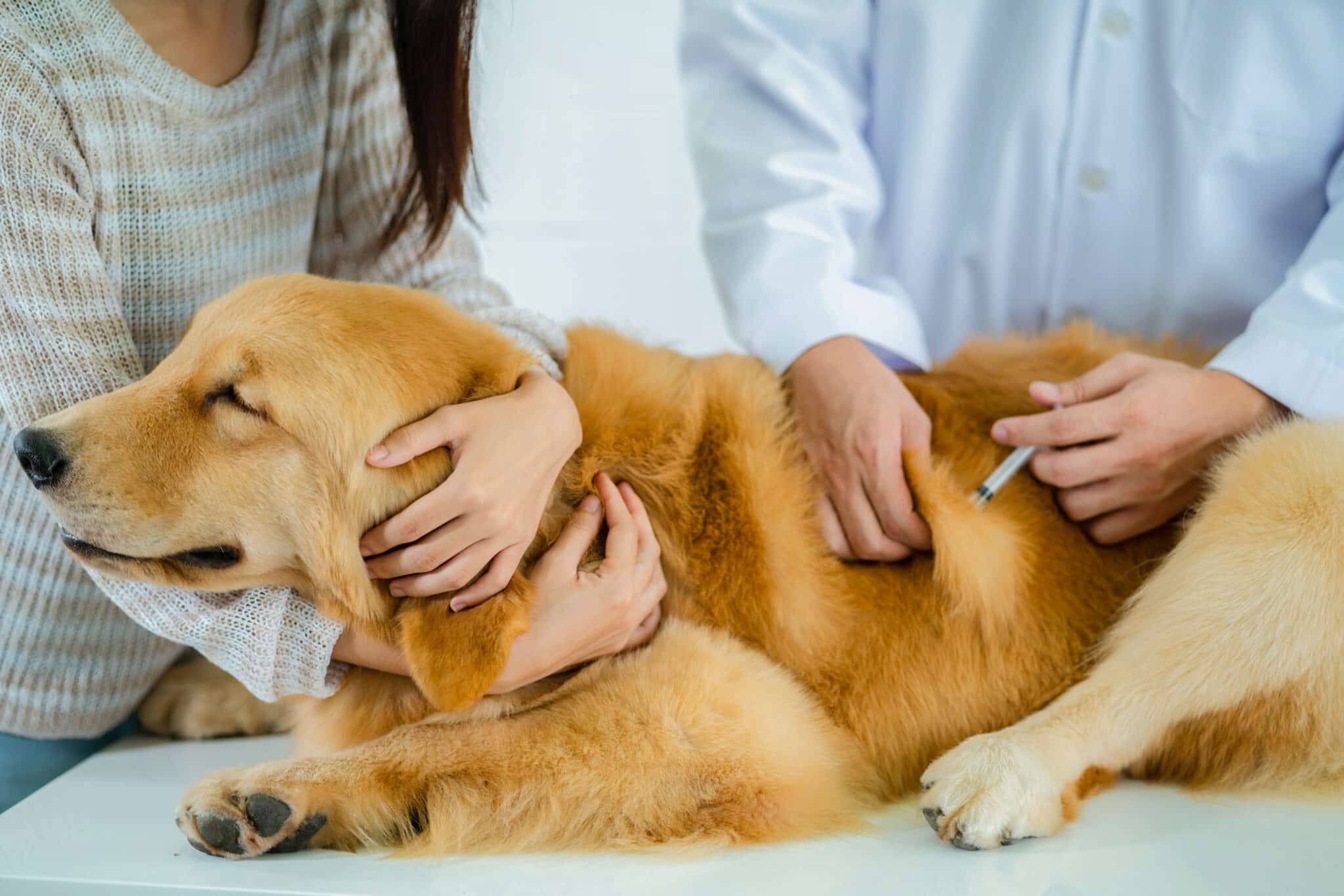Average Pet Insurance Cost
According to our research, pet insurance costs $720 a year for dogs and $384 for cats, with an overall average monthly cost of around $46 per month. To determine pricing, our team secret-shopped with 21 national pet insurance providers and gathered over 17,330 quotes in all 50 U.S. states.
Average Monthly Pet Insurance Cost by State
You can use the table below to find the average cost of pet insurance in your state:
| State | Average Cost for Dogs | Average Cost for Cats |
|---|---|---|
| Alabama | $47 | $27 |
| Alaska | $58 | $33 |
| Arizona | $67 | $34 |
| Arkansas | $49 | $30 |
| California | $72 | $41 |
| Colorado | $74 | $39 |
| Connecticut | $89 | $43 |
| District of Columbia | $78 | $41 |
| Delaware | $65 | $37 |
| Florida | $60 | $32 |
| Georgia | $62 | $33 |
| Hawaii | $64 | $33 |
| Idaho | $58 | $31 |
| Illinois | $68 | $35 |
| Indiana | $54 | $30 |
| Iowa | $64 | $33 |
| Kansas | $65 | $32 |
| Kentucky | $52 | $27 |
| Louisiana | $47 | $27 |
| Maine | $62 | $32 |
| Maryland | $72 | $38 |
| Massachusetts | $76 | $38 |
| Michigan | $61 | $31 |
| Minnesota | $53 | $28 |
| Mississippi | $54 | $28 |
| Missouri | $53 | $28 |
| Montana | $49 | $26 |
| Nebraska | $53 | $29 |
| Nevada | $54 | $31 |
| New Hampshire | $70 | $37 |
| New Jersey | $68 | $36 |
| New Mexico | $65 | $34 |
| New York | $71 | $37 |
| North Carolina | $63 | $32 |
| North Dakota | $48 | $27 |
| Ohio | $59 | $32 |
| Oklahoma | $56 | $31 |
| Oregon | $63 | $33 |
| Pennsylvania | $54 | $30 |
| Rhode Island | $51 | $28 |
| South Carolina | $56 | $31 |
| South Dakota | $57 | $30 |
| Tennessee | $55 | $29 |
| Texas | $56 | $30 |
| Utah | $58 | $31 |
| Vermont | $54 | $29 |
| Virginia | $60 | $32 |
| Washington | $62 | $32 |
| West Virginia | $54 | $27 |
| Wisconsin | $55 | $28 |
| Wyoming | $53 | $31 |
We gathered the above quotes based on an accident and illness policy for the following sample pet profiles, which generally cover a wide range of pet types and ages.
- A 3-month-old kitten
- A 3-month-old puppy
- A 1-year-old medium, mixed-breed dog
- A 1-year-old domestic shorthair cat
- A 2-year-old Siamese cat
- A 2-year-old golden retriever
- A 5-year-old medium, mixed-breed dog
- A 5-year-old mixed-breed cat
- An 8-year-old domestic shorthair cat
- An 8-year-old small, mixed-breed dog
Our team gathered an average of 815 quotes per provider across these species in all 50 U.S. states.
Cost of Pet Insurance by Provider
You will also find that the provider you choose impacts the price you pay, even when your pet and coverage details remain constant. Compare costs between the best pet insurance providers:
How Much Does Pet Insurance for Dogs Cost?
According to quotes gathered across all 50 U.S. states, pet insurance costs $63 per month for adult dogs and $46 for puppies.
Pet Insurance Cost by Dog Breed
The breed of your dog can factor into the price of a pet insurance plan. Some dog breeds are more prone to certain illnesses and conditions than others, such as French bulldogs.
“Purebred breeds are subject to several different types of genetic and medical problems. As an example, Persian cats, French bulldogs and other short-nose dog breeds can have breathing problems related to the structure of their noses and soft palates. Other breeds are subject to various conditions such as heart problems, eye problems or seizures. Even animals that are not purebred can have health problems — obese dogs may rupture their cruciate ligaments. Other examples include cancer, heart disease and serious gastrointestinal issues.”
According to Dr. Bonnie Beaver, DVM and Professor in the Department of Small Animal Clinical Sciences at Texas A&M School of Veterinary Medicine and Biomedical Sciences
You can compare the average monthly costs of insuring popular dog breeds with the chart below.
| Dog Breed | Average Cost | Cost With Wellness Coverage |
|---|---|---|
| French bulldog | $92 | $109 |
| Chihuahua | $29 | $47 |
| Golden retriever | $61 | $78 |
| Labrador retriever | $62 | $79 |
| German shepherd | $57 | $77 |
| Yorkshire terrier | $35 | $51 |
| Shih Tzu | $35 | $54 |
| Goldendoodle | $44 | $61 |
| American pit bull terrier | $58 | $77 |
| Pitbull | $59 | $79 |
Pet Insurance Cost for Dogs by Provider
Pets Best and Healthy Paws offer the cheapest pet insurance plans for dogs, on average. You can compare the monthly rates of our top-rated providers below.
| Company | 3-month-old Puppy | 1-year-old Medium Mixed-Breed Dog | 2-year-old Golden Retriever | 8-year-old Small Mixed-Breed Dog | 8-Year-Old Small Mixed-Breed Dog |
|---|---|---|---|---|---|
| Lemonade | $54 | $49 | $57 | $35 | $72 |
| Spot | $72 | $72 | $104 | $93 | $124 |
| ASPCA Pet Health Insurance | $46 | $46 | $67 | $60 | $78 |
| Embrace | $61 | $59 | $94 | $72 | $87 |
| Figo | $14 | $14 | $38 | $49 | $28 |
| Pets Best | $35 | $33 | $54 | $42 | $51 |
| Healthy Paws | $37 | $38 | $62 | $56 | $51 |
| Trupanion | $70 | $116 | $191 | $138 | $147 |
| Many Pets | $36 | $33 | N/A | $44 | N/A |
| Fetch | $44 | $45 | $61 | $70 | $86 |
How Much Is Pet Insurance for Cats?
The average cost of pet insurance for cats is $32 per month for adult cats and $25 per month for kittens. The exact cost of cat insurance will depend on the cat’s breed and age and where you live.
Cat Insurance Cost by Cat Breed
As you can see in the chart below, the cost of accident and illness coverage for cats can vary depending on your pet’s breed.
| Cat Breed | Average Cost | Cost With Wellness Coverage |
|---|---|---|
| Ragdoll | $27 | $43 |
| Main coon | $31 | $46 |
| Devon rex | $29 | $43 |
| Exotic shorthair | $30 | $44 |
| Persian | $31 | $45 |
| British shorthair | $31 | $46 |
| Abyssinian | $30 | $44 |
| Scottish fold | $30 | $45 |
| Sphynx | $31 | $46 |
Cat Insurance Cost by Provider
Based on our review, Healthy Paws and Pets Best are the cheapest pet insurance plans for cats. Compare the average monthly rates of our top-rated providers below.
| Company | 3-Month-Old Kitten | 1-Year-Old Domestic Shorthair Cat | 2-Year-Old Siamese Cat | 5-Year-Old Mixed-Breed Cat | 8-Year-Old Domestic Shorthair Cat |
|---|---|---|---|---|---|
| Lemonade | $32 | $31 | $26 | $28 | $52 |
| Spot | $36 | $36 | $36 | $41 | $65 |
| ASPCA Pet Health Insurance | $24 | $24 | $24 | $27 | $44 |
| Embrace | $32 | $27 | $41 | $45 | $67 |
| Figo | $14 | $13 | $14 | $22 | $17 |
| Pets Best | $22 | $21 | $24 | $23 | $41 |
| Healthy Paws | $14 | $15 | $21 | $26 | $32 |
| Trupanion | $30 | $49 | $55 | $70 | $105 |
| Many Pets | $33 | $21 | $21 | $50 | $42 |
| Fetch | $27 | $26 | $28 | $40 | $62 |
*Our team calculated costs using plans with unlimited annual coverage for all providers except for Figo, which includes a $5,000 annual limit.
How We Gathered Cost Data
Our team reviewed pet insurance companies in-depth to provide the most accurate and up-to-date pricing information available. While pet insurance pricing will vary based on your pet’s personal details, we took the following steps when collecting data to get a full scope of industry pricing.
- Overall cost averages: We pulled individual quotes from each of our recommended pet insurance providers for every state, using individual pet age, breed and other data points as indicated. After pulling hundreds of quotes encompassing the entire U.S., we removed major outliers to create an inclusive and representative average.
- Cost data by provider: To determine cost data for each provider, we pulled sample quotes with similar criteria for a fair comparison between companies. We also pulled quotes using the same pet data from multiple states and then averaged all costs together for four breeds.
- Cost data by breed: We evaluated cost data for 30 dog and cat breeds. To gather this information, we averaged quotes for each breed from five providers via PetInsurer.
- Cost data by age: We looked at pet insurance quotes for younger cats and dogs, adult pets and senior pets to compare cost changes as a pet ages. We collected breed- and provider-specific data for each age range and repeated our method of pulling individual price data from each state to get a comprehensive average.
We manually collected all cost information from each company’s respective website. Learn more about our review standards.
What Affects The Cost of Pet Insurance
Your pet’s age, breed and location, and the chosen coverage options and discounts will all impact the overall cost of insuring your pet.
1. Coverage Options
Most pet insurance providers allow you to customize your annual limit, deductible and reimbursement rate. You will generally pay the lowest monthly premium if you choose a low annual limit, low reimbursement percentage and high deductible. However, you will pay more out of pocket when your pet goes to the vet.
2. Pet Breed
Breeds with a higher risk of certain health conditions will cost more to insure each month. Purebred pets can be predisposed to illnesses that can make veterinary care more expensive, driving up the price of a pet insurance policy.
3. Pet Age
The cost of covering older pets will always be more expensive than younger ones, but each provider has different policies about when and how it raises premiums.
Most pet insurance companies allow you to enroll your pet at 6 weeks old. Some companies have a maximum age limit for enrollment, often ranging from 10 to 14 years. Therefore, if you have an older dog or cat, you’ll need to find a company for senior pets that does not have upper age limits.
When Should You Enroll Your Pet in a Plan?
Patrik Holmboe, the head veterinarian at Cooper Pet Care, suggests the following:
“Overall, the best time to enroll your pet in pet insurance is when they are young and healthy. Basically, the sooner, the better.”
Most pet insurance companies do not cover pre-existing conditions, and a pet’s chance of developing such health issues increases with age. Holmboe added,
“Most policies are cheaper for younger pets. If you start early, most insurance policies allow you to either lock in this lower price or gain some form of discount as the animal ages.”
4. Where You Live
Your location also plays a role in the price you will pay for any type of insurance coverage — not just pet insurance. Different states have different laws and regulations that dictate insurance pricing, what data a company can collect from consumers and what benefits providers must include with coverage. For example, while most states allow insurance providers to collect credit score information to determine rates for things like homeowners and auto insurance, California and Hawaii forbid insurers from collecting this information.
As a result of variations in state law, insurance companies take on different levels of risk depending on the policyholder’s residence. Pet insurance is no exception — in our review, we found significant variance in coverage rates between states.
5. Provider Chosen
The provider itself impacts the premium you pay. Each company assesses risk a little bit differently, weighing some factors more than others. That can lead to varying costs for identical policies based on the provider you choose. Based on our analysis, Lemonade offers great value by combining affordable prices with comprehensive coverage.
6. Discounts Offered
Many providers offer discounts when you enroll multiple pets or pay for your annual coverage upfront. Additionally, some providers offer discounts for policyholders who are military members or animal care workers. Compare top companies’ discounts below.
| Provider | Annual Payment | Multi-Pet | Military Members | Animal Care Workers |
|---|---|---|---|---|
| Lemonade | ✔ | ✔ | ✘ | ✘ |
| Spot | ✘ | ✔ | ✘ | ✔* |
| Healthy Paws | ✘ | ✘ | ✘ | ✘ |
| ASPCA | ✘ | ✔ | ✘ | ✔ |
| Embrace | ✘ | ✔ | ✔ | ✘ |
| Figo | ✘ | ✔ | ✘ | ✘ |
7. Pre-existing Conditions
Some companies’ pet insurance premiums will cost more if your pet has a pre-existing condition. Although most companies do not cover pre-existing conditions, some will ask about your pet’s health history when signing up for a plan and take your answers into account before giving you a quote.
“The number of [pet insurance] companies and options may be overwhelming, but if you do your homework, this may very well be the best option for your pet. The only possible downside is that if you don’t get [coverage] immediately and/or adopt a grown dog, the insurance still may not cover certain pre-existing conditions.“
What Is the Cheapest Pet Insurance?
The cheapest pet insurance company is Figo, with an average policy cost of $22 per month, with Pets Best coming in second at $33. On the higher end, Trupanion Pet Insurance has an average monthly cost of $97. The table below ranks the top five most affordable pet insurance companies in order of cost, based on our analysis.
How Does Pet Insurance Work?
Pet coverage works similarly to other forms of insurance, such as auto or property insurance. You pay a premium and in return, the insurer covers the cost of services listed in your contract. There are a few steps to the process of getting and using your pet insurance plan:
- Enroll: The first step is policy enrollment, in which you choose a provider and plan and sign up. We get into more detail about how to choose the best coverage options for your pet later in this guide.
- Wait for coverage to begin: Providers typically enforce waiting periods or the time you must wait before coverage will begin, typically ranging from two days to two weeks. During this time, your pet is not eligible for coverage and you will have to pay for care out of pocket. The insurer will consider any conditions that occur during the waiting period as pre-existing and may not extend future coverage.
- Get and pay for treatment: When you need a covered veterinary service, you’ll take your pet in for care just as you would without insurance. You will need to cover the bill at the time of the appointment and file for reimbursement later unless your insurance provider offers vet direct pay.
- File a claim: Just as you would for other types of insurance, you’ll need to file a claim to have the cost of your pet’s care reimbursed by your pet insurance provider.
- Get reimbursed: Once your insurer approves your claim, it will reimburse you for covered costs up to your policy’s coverage limit and reimbursement rate, minus any deductible.
How much of a veterinary bill your pet insurance provider will cover depends on your chosen reimbursement rate. In general, the higher your reimbursement level, the higher your monthly premium and vice versa.
Do All Veterinarians Accept Pet Insurance?
Yes, you can go to any veterinarian when you have pet insurance. Typically, you will pay your full vet bill upfront and file a claim to your insurance company for reimbursement. Once your pet insurance provider approves your claim, you will be reimbursed for your vet visit. The percentage of total expenses your provider will cover depends on your plan options.
If you want to avoid filing a claim and waiting for reimbursement, some providers like Trupanion and Pets Best partner with vets to automatically process your reimbursement, so you don’t have to pay the whole bill upfront. This sometimes limits which vets you can go to, as it requires that the clinic be partnered with the insurance provider.
Average Costs of Pet Medical Treatments
According to our analysis, the average cost of an emergency vet visit is anywhere from $374 to $1,285. However, surgeries and hospitalizations will cost much more.
The out-of-pocket cost of pet medical care can rack up quickly. Serious procedures or treatments such as ACL surgery, chemotherapy and foreign object removal can cost thousands of dollars. But even treatments for common ailments such as diarrhea or ear infections can cost hundreds.
In the table below, you’ll see out-of-pocket cost ranges for common veterinary treatments to see what you might pay if you don’t have pet insurance.
| State | Average Vet Visit Cost |
|---|---|
| Alabama | $61.26 |
| Alaska | $80.06 |
| Arizona | $79.28 |
| Arkansas | $68.06 |
| California | $71.45 |
| Colorado | $77.72 |
| Connecticut | $93.44 |
| Delaware | $76.41 |
| Florida | $60.41 |
| Georgia | $67.10 |
| Hawaii | $69.28 |
| Idaho | $67.72 |
| Illinois | $70.89 |
| Indiana | $74.39 |
| Iowa | $60.74 |
| Kansas | $56.09 |
| Kentucky | $61.30 |
| Louisiana | $63.33 |
| Maine | $81.08 |
| Maryland | $80.65 |
| Massachusetts | $85.06 |
| Michigan | $52.78 |
| Minnesota | $76.94 |
| Mississippi | $70.55 |
| Missouri | $65.94 |
| Montana | $55.72 |
| Nebraska | $55.00 |
| Nevada | $65.44 |
| New Hampshire | $75.32 |
| New Jersey | $87.11 |
| New Mexico | $66.79 |
| New York | $84.72 |
| North Carolina | $66.67 |
| North Dakota | $62.97 |
| Ohio | $58.43 |
| Oklahoma | $53.44 |
| Oregon | $65.94 |
| Pennsylvania | $65.91 |
| Rhode Island | $79.17 |
| South Carolina | $73.00 |
| South Dakota | $60.58 |
| Tennessee | $64.56 |
| Texas | $66.81 |
| Utah | $70.11 |
| Vermont | $73.54 |
| Virginia | $69.67 |
| Washington | $79.74 |
| West Virginia | $64.28 |
| Wisconsin | $71.11 |
| Wyoming | $61.42 |
What’s the Best Pet Insurance for Your Budget?
Multiple pet insurance providers operate nationwide, and you can find the best plan for your pet and your budget by researching several different companies. Compare the coverage options and services offered by each insurer, keeping in mind that the cheapest plan may not be the best plan if it does not provide the coverage your pet needs.
We recommend Lemonade, Spot and Fetch Pet Insurance as top providers that offer affordable yet comprehensive accident and injury plans. Many providers offer wellness add-ons to cover routine preventive care, such as wellness visits, vaccines, parasite prevention, and spay or neuter surgery.
Lemonade is our overall top choice for affordable pet insurance because it offers lower-than-average monthly premiums with customizable options that allow you to build a plan that works best for your budget. Lemonade also offers a 10% discount if you bundle pet insurance with a homeowners or renters policy, which can lower your premium even more.
Cost-Saving Preventative Care Tips
Preventative care can help keep your pet healthy and reduce the chance of illnesses that require expensive veterinary treatments.
Dr. David Emery, DVM, an assistant professor at Michigan State University College of Veterinary Medicine, highlighted a few important preventative care tips for pet owners.

“The four best preventative care things you can do for your pets are:
- Go to the vet annually and follow the recommended vaccine protocol,
- Test for heartworm and tick-borne diseases and use prevention,
- Keep your pet at a healthy weight,
- Make sure your pet’s teeth are healthy, either from dental treatments or toothbrushing.”
Our Conclusion
Everyone’s circumstances are different, so our team recommends carefully weighing the costs and benefits of enrolling in a pet insurance plan. If you own a high-risk dog breed or live in an area where veterinarian health care is expensive, pet insurance may offer a good option for offsetting care costs.
Still, experts suggest it’s at least worth taking a look at pet insurance plans to see if coverage is a good fit for you and your furry friend.
“Consider purchasing pet insurance. The hope with insurance is always that you will not need to use it, but it can make all the difference if something expensive comes up.”
—Dr. Kristi Flynn, DVM, Associate Professor of Primary Care and Veterinary Clinical Sciences at the University of Minnesota College of Veterinary Medicine
Pet insurance offers a way to help cover the cost of proper veterinary care for your pet. But whether you invest in a policy or not, experts such as Dr. Gene Pavlovsky, DVM, DABVP, FFCP, LSHC-S, an instructor in small animal primary care at the University of Illinois Veterinary Teaching Hospital, insist that getting regular care for your pet is foundational to giving it a long, happy and healthy life.
“Establish a trust-based relationship with your veterinarian. There is no substitute for regular physical examinations and conversations with your veterinarian — this is probably more important than any single product or service. Seeing your veterinarian regularly and having your pet examined can help uncover many chronic conditions in the early stages and lead to steps that may change the course of disease for the better.”
Our recent survey found that most pet owners can only afford $500 out of pocket and that one-third of pet owners are entirely unprepared financially to pay for an emergency vet bill for their pet.
Expert Tips and Insights
like to get paid money and if your planning on putting the $50-$100 a month to prepare for a pet emergency I would argue putting that money in a savings account or investing it would be a better use of your money.”

keep a savings account or have pet insurance to cover routine and unexpected medical expenses. This helps ensure that appropriate care can occur based on the animal’s medical need and not on the cost of care.“

in a number of different ways. I think the most unsuccessful one is to expect not to have an emergency at some point throughout the life of your pet.
One option is to get a credit card specifically for your pets. You build credit by using it to pay for wellness-type visits, then pay those off quickly. You will then have available credit ready should you need it.
Another option is to budget and save money each month toward the possibility of an emergency. This has the benefit that if not used, you will still have access to the money (as opposed to insurance). A drawback is that if the emergency occurs early in your pet’s life, you may not have saved up enough to cover the costs.
Since these options both have their drawbacks, a growing trend is pet health insurance. The number of companies and options may be overwhelming, but if you do your homework this may very well be the best option for your pet. The only possible downside to this is that if you don’t get it immediately and/or adopt a grown dog, the insurance still may not cover certain pre-existing conditions.”

current medical records are easily accessible in the event of internet failure and that pet parents always have an adequate supply of prescription medications. It may be a good idea to set aside and regularly contribute to a small fund that can be used to supplement the cost of a medical emergency; similarly veterinary insurance policies that help offset the cost of illness and emergency treatment could help. Having contact information on hand for those family members or friends that can help during such stressful times could be valuable in an emergency as well.

always that you will not need to use it, but it can make all the difference if something expensive comes up. Alternatively, set up a savings account that you can use for pet emergencies should one come up. It is also good to have a plan for how you would make decisions considering your pet’s quality of life and your values and financial situation well in advance of a stressful situation. If there are multiple caretakers, having these conversations together beforehand can help guide your decisions when and if the time comes.”

Frequently Asked Questions About Pet Insurance Cost
Pet insurance gives pet owners peace of mind and financial security, knowing they won’t have to pay a very high vet bill when their pet has an unexpected injury or illness. However, pet insurance can be expensive depending on your chosen plan and provider. Additionally, if your insurance provider does not pay your vet directly, you’ll still have to pay the full vet bill and wait for a reimbursement.
Most pet insurance providers will cover dental accidents and illnesses but not routine dental care. Some providers, like Lemonade, require you to select an add-on to cover most dental treatments.
Most cat and dog insurance plans only cover the cost of accidents. illnesses and hospitalization, not routine care. However, most insurance providers offer an optional wellness plan that extends coverage to include preventative and routine care like checkups and vaccinations.
Methodology: Our System for Rating Pet Insurance Companies
If you have feedback or questions about this article, please email the MarketWatch Guides team at editors@marketwatchguides.


















